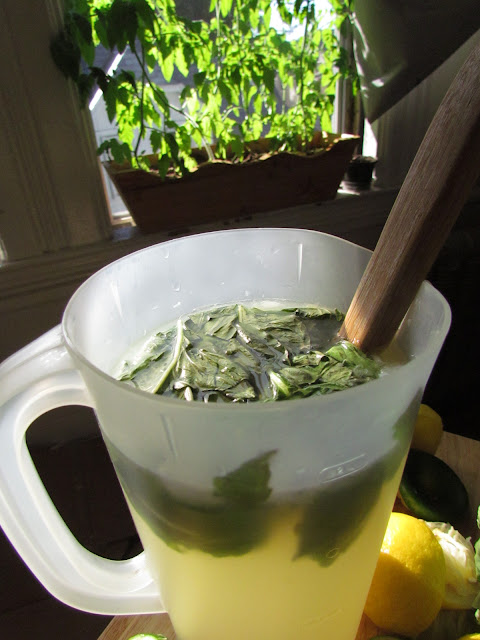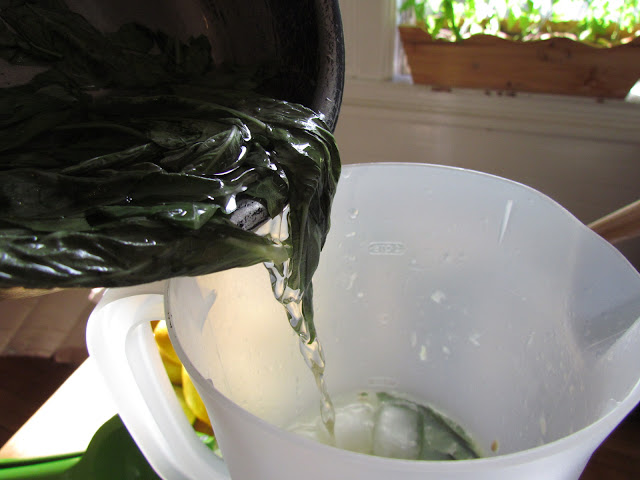My introduction to the blogging world (well...the
good blogging world - Xanga doesn't count, although
other good things have come out of that) was through food blogs. Blogs like
Smitten Kitchen,
Macheesmo, and
Culinary Concoctions by Peabody have a way of taking the ordinary (remember cheese-sandwich blogs? This is what I had for lunch today...and this is what I had for lunch yesterday) and giving it the Hollywood treatment. To this day, I'll turn to a food blog for a new recipe over America's Test Kitchen or The Joy of Cooking. Where a cookbook has very little leeway to go off and talk about how you should go about altering recipes when you live in a tiny apartment with an oven that runs a hundred degrees hot, you might find a food blogger (who hopefully has several hundred readers/commenters) who is in exactly your predicament. The best bloggers also have a bit of an artistic eye, and can make beef stew in an old brown dish look like something from
El Bulli.
This is just to say, I am not one of those food bloggers. What I am is a warmish Bostonian with a summer afternoon off, gorgeous light coming through the south-facing windows, and quite a lot of basil in the fridge.
 |
| Lemonade? Lemonade. |
Basil Lemonade Recipe
Before I start, I should add a disclaimer: what I'm making here is not straight-out-of-the-pitcher drinkable. It's more of a lemonade concentrate that you pour into a glass and add water to taste. So take these ratios with a grain of salt and far less sugar than I used.
Ingredients:
8 lemons or limes or some combination thereof
2 cups sugar
2 cups water + extra to taste
2 cups fresh basil
Helpful equipment:
A sharp kitchen knife
A 2-liter pitcher
A citrus juicer (I have something like
this)
Process
1. Start making your simple syrup. Combine 2 cups of water and 2 cups of sugar (or any 1:1 ratio) in a saucepot. Turn the heat up to medium-ish. Stir until the sugar dissolves. Simmer for 5 minutes, then remove from heat. And let cool slightly.
2. Once the syrup has cooled (not a lot - you should just barely be able to stick a finger in it without burning yourself), bruise the basil lightly and add it to the pot, reserving some for garnish. Let sit while you juice the lemons, or for at least 20 minutes.
3. Cut all of your citrus in half. Squeeze into your serving pitcher.
4. Once your syrup has cooled significantly (room temperature or so), pour it into the pitcher and stir.
5. Fill the rest of the pitcher with water.
Serving:
Pour about 4 oz. of lemonade concentrate into a glass. Add water and ice to taste. Garnish with reserved basil sprigs.
You can follow the recipe above (mentioning again: concentrate, not something you want to chug), or you can do it the way I did it.
Once you've assembled your ingredients, you should realize that you'd like to blog about this later, and that the light is perfect, and you may not get another chance like this for weeks. Get your camera.
Set up in front of the only part of the apartment not covered in books or dishes or small pieces of electronics and carefully frame your shots so both the ugly box fan and the ugly radiator never appear.
Start taking pictures of your ingredients, then realize that it's de rigeur to assemble everything first and take a "group shot". Also take a moment to note that the tomato situation in the background has gotten very much out of hand.
Get out your limes and lemons and put them in a pot. Measure out the last two cups of sugar and vow to go to CVS later so your boyfriend won't be sad in the morning when he has no sugar for his coffee. Get out a huge handful of basil that you bought from the store, even though your herb garden has gone wild downstairs. Tell your boyfriend that it's because you want to make basil-something-else later in the week, and you don't want to decimate the basil crop.
Start taking artsy shots of your food. Pretend you're a food stylist.
You can use all lemons, all limes, or some combination. I tend to favor lemons, so I used a 5:3 ratio (one wouldn't fit nicely in the pot).
Pour your two (!) cups of sugar into a saucepot. Don't try to replace this with artificial sweetener. The result is something very much unlike the lemonade we're making here.
Add two cups of water. (You could be using any 1:1 ratio. Simple syrup keeps for months in the fridge, so make extra if you're so inclined.)
I made an artistic choice not to show you my tiny, tiny kitchen with the stubborn splatters on the wall, so just believe me when I say that I put the pot on the stove and turned the heat up to medium. I also stirred until the sugar dissolved, and let it simmer for five minutes. Then I took it off the heat to cool down slightly.
In the meantime, juice your citrus. Like Alton Brown, I am against unitaskters. HOWEVER.
- This particular unitasker just about doubles the amount of lemon juice I can get out of a lemon.
- It is less than fun to hand-squeeze sixteen lemon halves.
I justify it by thinking of all the money I'm saving by not buying double the amount of lemons.
Cut all of your citrus in half.
Take a picture of the helpful bird that's wandered by.
Now, I have a question for you folks. Wouldn't you think that, lemon juicers being shaped as they are, you'd put the lemon in this way?
So did I. But I was over on
Smitten Kitchen the other day, and she had put the lemons (limes, actually) in upside-down, so the rind was facing up, like so:
I tried it both ways, and I have to say that the upside-down way works better to catch the seeds, although you do get a bit more pulp. Which way do you use a lemon juicer?
If you're diligent, you can get about a third of a liter of juice out of eight lemons. Try squeezing each one twice or three times, shifting the rind a bit each time, to get the most juice out of them. I think limes are a bit more juicy "per capita" than lemons, but this recipe is so flexible, it shouldn't matter.
Leave your artfully stacked citrus rinds for the moment, and go back to your pan of simple syrup. You want to catch it before it cools down to room temperature, but after it's done simmering. Luckily, since there's so much sugar in it, this is quite a long window. Your goal is to infuse the syrup with basil flavor without denaturing the alcohols that give it its smell and taste.
Test your syrup to see if it's cooled down enough by putting a small basil leaf in and stirring. If after 30 seconds, the leaf is still mainly bright green, that's a good temperature. If it wilts and turns a dull green or brown, put the pan in the fridge for a few minutes to cool off.
Add your giant handful of basil to the pan. The more basil you use here, the happier you will be later. (Do save a few sprigs for a garnish - that's not just an aesthetic thing, it's important for the taste, too.)
Stir and let sit. The longer you let this sit, the more intense the basil flavor will be. (Also, folks, if you wanted to stop right here, pour all of this in a dish, throw it in the freezer and stir it every hour or so, you'd end up with an unusual and very refreshing basil granita. I won't tell.)
After 20 minutes (or however long you can wait), add about half the syrup into the pitcher. I added the whole darn thing, and it was too sweet, so take it slowly! (Alternative option: add water first and sweeten to taste.)
 |
| Take a moment to note that the differing viscosities between water and simple syrup give this photo a different character than the photo of the water pouring above. |
Add water to the top of the pitcher, and you're done! Leave the basil in there. It'll get better with time.
Notes:
- This is very sweet, very concentrated lemonade. I would cut down on the sugar next time, and I love sweet things.
- Having made this with 8 lemons vs. a mixture of limes and lemons, I'd say that the limes cut the tartness a little bit, although they were juicier. I can't say I have a strong preference either way.
- A 1:1 ratio of concentrate to water makes a pretty darn good drink, although it could be tarter.
- A basil garnish is a must. Smell is the better part of taste, and although you will taste the basil if you let your syrup sit long enough, burying your nose in a sprig of basil as you go to take a drink really hits it home.
- Folks, if you don't try this with gin, your world will be darker and smaller forever.
Have you tried basil lemonade before? Let me know in the comments!









































